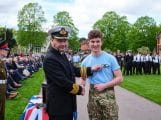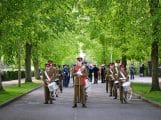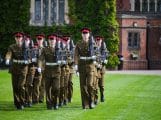RAF claim drill trophy whilst Army win ‘Gun Run’ at 66th CCF Annual Review

Saturday 4 May saw the 66th Annual Review of our Combined Cadet Force. Cadets from all three Services and each of the Foundation’s senior schools paraded in the Loughborough Grammar School Quad in front of Reviewing Officer, Captain Chris Ansell RN, in what was undoubtedly one of the finest shows of cadet drill and teamwork in the country.
The fiercely competitive teams of each section battled to secure their place in history over the gun run and the drill competition, with the RAF section claiming this year’s drill trophy and the Army section taking the win in the gun run, narrowly missing out on setting a new Foundation record.
Major Ben Ward, CCF Contingent Commander says: ‘Captain Ansell was impressed by the Contingent’s high standards and enthusiasm and was pleased to award civilian flying wings to a Year 11 boy, scholarship certificates to three departing Year 13 Army cadets and re-award to members of the RAF section their trophies as National Champions and current holders of the Royal Air Squadron Trophy. Addressing the Contingent, he spoke of their impressive dedication and outstanding teamwork.’
He adds: ‘As well as other departing Year 13 cadets, both the Regimental Sergeant Major and Lord Lieutenant’s Cadet, who carried the Brockhurst sword in memory of the late Major David Brockhurst (LGS 1950), spoke of their pride in the cadets and having had the opportunity to develop into such inspiring role models to their peers.’
For many, the highlight of the CCF Annual Review is the Gun Run, where teams of eight from the three services compete to dismantle a life-size model field gun, take it across an aerial runway, and then reassemble it to fire three blank rounds. This is done against the clock for the Hipkin Shield and in the last few years the cadets have been taking it even more seriously, trying to break the legendary 2-minute barrier.
The origins of a field gun competition in the military lie in the Second Boer War in South Africa. The famous story is of the relief of the siege of the British garrison at Ladysmith in 1899 when, in support of the British Army, the Royal Navy landed guns from HMS Terrible and Powerful and the Naval Brigade transported them over very difficult terrain before bringing them into action against the Boers.
John Weitzel, the LGS School Archivist, has found the earliest mention of a Competition at the school in 1990 and before the CCF was opened up to the High School. The Contingent Commander at the time, George Beazley, created two model field guns, the second of which is the one we still use today. As it was not possible to buy something like that at the time, he built them in the school workshops and the aerial runway (or ‘rig’) was made from materials sourced from the Army. The ‘rig’ now comprises purpose-bought elements, including the new pine poles used for the first time this year which were kindly paid for by the Parents’ Associations of all three senior schools.
LGS Assistant Head Alasdair Waters (LGS 1996) says: ‘Although exciting, the safety of such an undertaking is paramount. The runway is constructed by the Engineer Section and the competing cadets have four weeks of training and practice in the build-up. To give an idea of what they are undertaking the total weight of the gun is 113kg. When dismantled into its constituent parts the heaviest is the barrel at 25kg and the two wheels go over together with a combined weight of 40kg. Of just as much weight, however, is seeing the cadets develop mutual trust, teamwork, leadership, and communication.’
He adds: ‘As well as the cadets having to undergo the required training, as with all things in the school, the gun run would not be able to take place without the expertise and commitment of staff and volunteers, for which we are extremely thankful. Peter Sergeant has been commentating on it since 1993 and undertakes the maintenance of the gun, this year, for instance, replacing the firing pin mechanism. CCF Staff Member Rob Lightfoot presides over construction of the ‘rig’ but also has responsibility for the health and safety aspects of the competition, with the parts being regularly tested by external assessors. He and Peter are always here early and late in the weeks leading up to the event providing the associated training that culminates in such a wonderful spectacle on Inspection Day itself.’







































